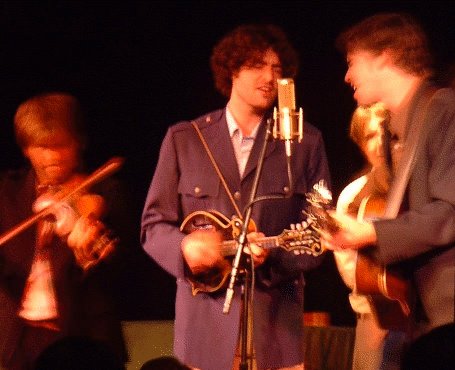

What's the story here? The original content is down at the bottom of the page - it's turned into a blog of sorts above that.
9-28-2005: Finally got to use the Earl for a real live show! I've been able to try it out during soundchecks with a couple of groups now, but a few days ago we had King Wilkie (great young bluegrass band, go see them!) at the Ark. They typically use a pair of small-diaphragm condensor mics on the sides, and an Audio Technica AT-4060 in the middle for vocals. Some weirdness in the 4060 that day resulted in us using the Earl instead. Sounded great, got a few compliments on the sound.

8-30-2005: If this is a blog, I need to update it more often.
Anyway, most recent news is that I just finished a second Earl, and I've got a third about half-done. I did some actual live testing a couple weeks ago, and the Earl worked very nicely. I had to EQ it slightly, but overall I had decent volume levels and a very natural sound. I couldn't get it obviously "loud" in the house, but on the other hand when I muted the mic(s) to compare the actual acoustic sound from the musicians was much quieter. Was even able to fold a bit of sound back into a wedge monitor onstage.
The Earl did the bulk of the testing. I've got plans to build the Mid/Side processing box to allow some mixing between left, right, and center around the mic. The Lester, with the front/back capsules for adjustable pattern, didn't really seem to matter that much. I'd guess that in a very specific situation that extra control would be nice, but indoors in a medium club room (The Ark) it really didn't make a difference.
8-1-2005: Another prototype! You really can't tell from the photo, but it is a bit different than the Earl mic. Plus the Earl body got polished and lacquered, so it looks a bit different than the earlier photos. And then there's the matching shockmount, which I'd built a few months ago for other mics.
The big difference with this mic is internal.
This new prototype (aka "Lester") is basically
monophonic but with two outputs. Depending on how you mix the outputs you
can go from omni to cardioid to figure-8, or anywhere in between. Should
be very handy for live shows with the one mic setup.
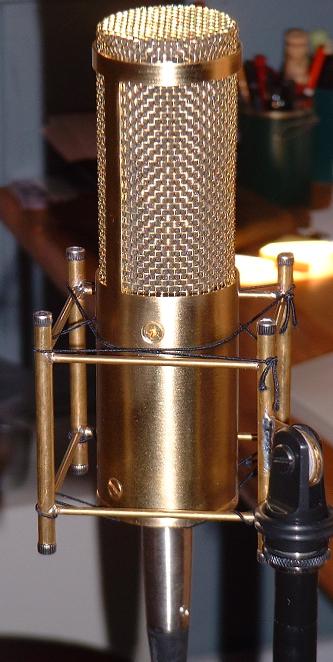
7-25-2005: A working prototype! Named "Earl", it still needs some work (especially the shockmounting stuff) but at least so far it works, produces a nice stereo sound, and looks good. And all the electronics fit into the lower section, so all it needs is an adapter cable.
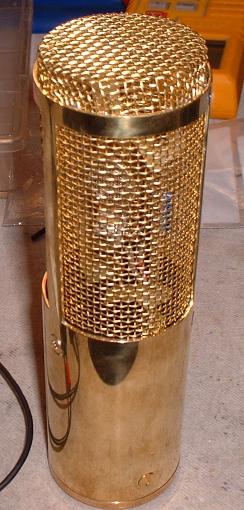
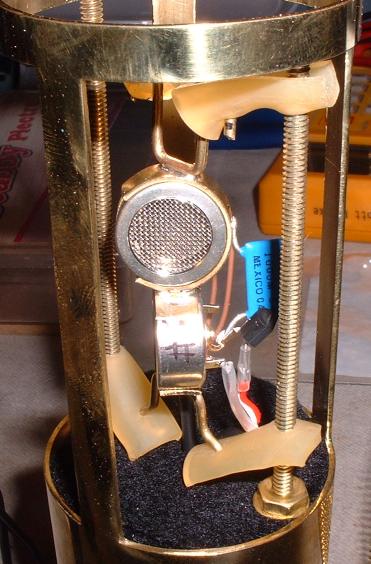
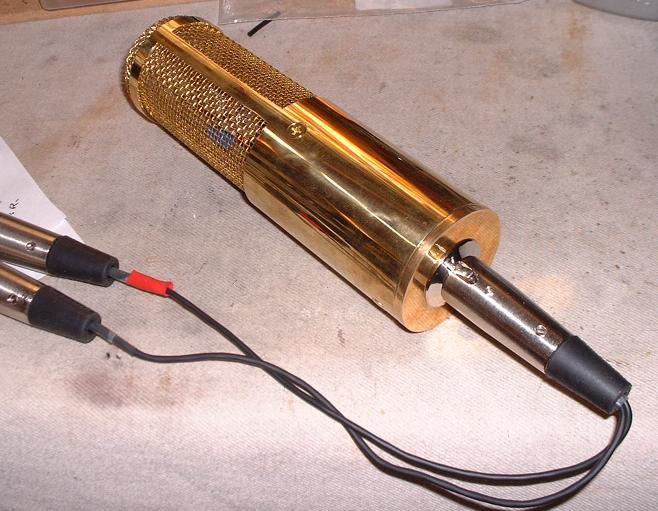
7-8-2005: Finally got around to buying 2" brass pipe and such for a prototype. Shiny! I'm going to go with a pair of SD capsules, 100 deg. splay or thereabouts, haven't decided on where the electronics will live. Shockmounting will be internal, stand mount will be fairly simple. Unlike the sketch above this will be a more conventional "studio mic" type of body.
Previous to July 2005:
So far still in reseach phase. But I thought I'd put up a page just to attract comments from people who have worked with this stuff.
Lately I've noticed a fair number of bluegrass groups going to the "one mic" (usually 2-3 mics, plus something for the upright bass) approach. Usual mic of choice is a large-diaphragm condensor, a "big studio mic". But actually I don't believe that's a good choice for live sound, since the pickup pattern isn't very even over the frequency range. So I've gotten into testing and so far I've determined that a stereo pair of small-diaphragm condensor mics in a coincident-diaphragm X is probably much better (a ribbon mic is nice too, and historically more correct, but not something you'd want to take anywhere windy!).
The "Big Bluegrass Microphone" is going to be a beautiful big mic shell, with a good vintage look, but containing an array of modern small condensor capsules. There may be a little mixer/EQ box, depending on how tricky the array gets. Ideally it would be something simple enough to plug into a PA channel and ignore, or have a live sound tech fine-tune things at a big show.
Please email with comments! scott@scotthelmke.com